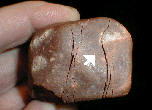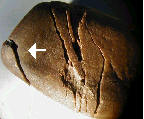|

| |
SHOCK-INDUCED SPALLATION IN TRIASSIC BUNTSANDSTEIN
CONGLOMERATES (SPAIN): AN IMPACT MARKER IN THE VICINITY OF LARGE IMPACTS
Kord Ernstson 1, Michael R. Rampino 2,
Michael Hiltl 3
1 Fakultät für Geowissenschaften, Universität Würzburg,
2 New York University & NASA Goddard Institute for Space Studies,
3 formerly Lawrence Livermore National Laboratory
|
In fracture mechanics, spallation is a well-known process
typically combining compressive and tensile stress. Spallation occurs when a
dynamic compressive pulse impinges on a free surface, where it is reflected as a
rarefaction pulse. The associated tensile stress may lead to internal spallation
fractures (Fig.1 a) and to complete spalls detaching from the free surface.
|
 
 
  
Fig.1. Spallation fractures in experimentally shocked ARMCO
iron (a)
and in naturally impact-shocked quartzite cobbles. b, c: Internal spall
fractures
and a nearly detached spall in c. d, e: Spallation craters.
Note the
central mound in d, and the opposite craters in e.
|
Here, we report on the natural occurrence of spallation in
Triassic Buntsandstein conglomerates induced by shock waves from nearby large
impacts. The conglomerates are exposed in a large area (several 1000 km²) and
surround the Azuara impact structure and especially its newly established [1, 2]
Rubielos de la Cérida companion impact structure in NE Spain (Fig.2).
|
|
The conglomerates are in general composed of quartzite
cobbles in a sandy matrix, and they are well known among geologists because of
the distinctly pock-marked and cratered cobble surfaces. Commonly, these
deformations are considered to have resulted from pressure dissolution by
overburden or/and tectonic compression. Recent studies [3] show that there is no
dissolution evidence and that the peculiar features and a distinct macroscopic
and microscopic sub-parallel fracturing are better explained by dynamic
deformation in the Azuara/Rubielos de la Cérida impact event. Among the
different aspects of these deformations [3], we consider spallation a very
effective and macroscopically significant process.
|
|
Fig.1 shows typical macroscopic spallation features in
cobbles sampled from the Buntsandstein exposures. The samples have sets of
distinctly open sub-parallel fractures with a very small spacing. There is no
shearing, and the materials are not broken to pieces. An origin from
quasi-static tectonic
|
|
deformation is hardly to understand physically. We specially
point out the spall fractures (arrows) mirroring the surface of the cobble. For
geometrical reasons, this is expected to occur as a result of the reflection of
a dynamic pulse at the free surface. In the case of the Buntsandstein cobbles,
there was not a free surface in the strict sense but a distinct contrast of
shock-wave impedance between the very dense quartzite cobbles and the sandy,
porous matrix. Perfect opposite spall craters are shown in Fig.3. We point to
the sharp contours of the craters as a result of brittle fractures and exclude
any dissolution processes. Spallation on a smaller scale is shown in Fig.3 (thin
section) and frequently occurs also on a microscopic scale [3].
|

Fig.2. Sketch-map showing the location of the Azuara (A)
and the Rubielos de la Cérida (R) impact structures
and the investigated
Buntsandstein conglomerates.

Fig.3. Photomicrograph (top; field is 6 mm wide) of a
detached spall (S)
in a Buntsandstein quartzite pebble, and spalls (arrows) in
experimentally
shocked quartz spheres (bottom, sphere diameter is 14 mm).
|
To investigate the conditions of spall-fracture formation in
cobbles, we performed shock experiments on quartz spheres at the Fraunhofer
Institute for High-Speed Dynamics in Freiburg/Germany (Fig.3). The impact
velocities ranged between 25 and 115 m/s corresponding to impact initial
pressures between about 0.55 and 2.5 GPa. Even at the lowest impact velocity (25
m/s), we observe clear spall fracturing in the spheres, and at higher impact
velocities, up to five spalls were observed to occur in one sphere together with
strong deformations described in more detail in [3].
|
|
Conclusions. - The Triassic Buntsandstein
conglomerates in northeastern Spain display clear and frequent spallation
effects resulting from dynamic deformations well known in fracture mechanics.
Because of the vicinity of the exposed conglomerates to the Azuara impact
structure and the newly suggested Rubielos de la Cérida companion crater, the
spallation is ascribed to shock waves from these impact structures having led to
internal accelerations within the conglomerates, multiple collisions of the
components, strong reverberations, and, by focussing effects in the spherical
bodies, to high compressive and tensile stresses even at very low impact
velocities.
|
|
Therefore, spallation features in conglomerates are suggested
as a strong macroscopic diagnostic tool to identify nearby impact sites where
other signature is weak or absent.
|
|
References. - [1] Ernstson, K. et al., this workshop;
[2] Hradil, K. et al., this workshop. [3] Ernstson, K. et al., Geology,
v. 29, No. 1, pp. 11–14.
|
|
